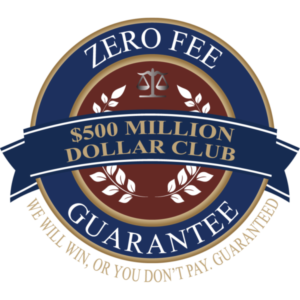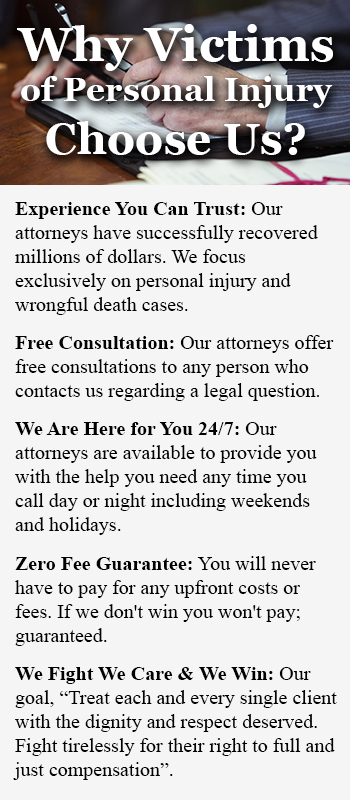Trip and fall accidents can cause serious and sometimes fatal injuries. There is a combination of factors that come into play when someone trips and falls on the stairs, including deficiencies in design, lighting, visibility, and attention. These factors are the culprits of the majority of slip and fall accidents involving stairways. More severe upper/lower extremity injuries occur when traveling down a stairway as opposed to traveling up. With respect to stairway descents, the tread-depth or horizontal surface must be adequate for the ball of the foot to land on tread without extending over the step below. If not, individuals over-step or misstep causing a forward fall.
If you have been injured due to a defective stairway, or if you fell down the stairs due to the negligence of another party, call our top-rated law office, Normandie Law Firm, to speak to an expert lawyer experienced in stairway accident cases. Our top legal team will work hard to bring you compensation, and you can be sure you’ll be represented by a skilled attorney who has experience handling trip and fall claims.
Who Can You Sue for a Slip and Fall on a Stairway?
Our law firm will need to study the details of your case to determine who you can sue for a trip and fall accident or slip and fall accident in a stairway. There are a variety of potential parties that you can sue for a slip and fall accident on stairs. You could sue the property owner, the property manager, the person who caused the unsafe environment to exist, the construction company that designed and built the stairway, and the insurance company of the property. First, we will need to know why you fell on the stairs. The reason is important. Read more below.
Riser and Tread Design
Research has shown that during stairway use, pedestrians view only the first and last three (3) steps, with the rest of the stairway negotiated without looking. Thus, the design of the top three steps and bottom three steps is very important.
Stairway Visibility
Poor visibility of both risers and treads lead to misreading the stair edge, which can cause faulty foot placement and a trip and fall accident.
To Increase Visibility
Provide visual contrast on tread nosings, or at leading edges of treads without nosings, so that stair treads are more visible for people with low vision. Surfaces that are covered with the color “safety yellow” are most visually detectable. Additionally, in lowly lit areas, highlight each step using step lighting.
Adequate Lighting
Adequate lights are vital to preventing trip and fall accidents down staircases. As people descend the stairway, the floor below and the treads are in their lines of sight, but the risers are not. Therefore, the top safety priority is to make treads more visible through contrasting nosings and adequate lighting.
Short Stairways
 A large number of stairway falls occur when individuals step off the top of the stairway into thin air. This type of fall is commonly known as “the air-step-fall.” Generally, these falls occur on low stairways consisting of one, two, or three steps. In effect, people step off into thin air, not having seen the stair or stairs at all. This type of fall commonly occurs inside public buildings such as hotels and restaurants. “Air-Step-Falls” occur when people fail to perceive the modest floor change and are usually the most serious accidents on low stairways.
A large number of stairway falls occur when individuals step off the top of the stairway into thin air. This type of fall is commonly known as “the air-step-fall.” Generally, these falls occur on low stairways consisting of one, two, or three steps. In effect, people step off into thin air, not having seen the stair or stairs at all. This type of fall commonly occurs inside public buildings such as hotels and restaurants. “Air-Step-Falls” occur when people fail to perceive the modest floor change and are usually the most serious accidents on low stairways.
An experienced attorney can explain more about the different types of falls and contributions to falls. If you tripped and fell, or slipped and fell in a stairway and need help filing a lawsuit to get the compensation that you deserve, contact our law firm for a free consultation. Our attorneys are highly experienced in stairway slip and fall cases, and they can get you the maximum amount of compensation.
Tripping Hazards
When people fail to notice a stairway, tripping is always a serious hazard. The biggest reasons for trip and fall accidents are inadequate stair dimensions, missing railings, improper railing heights, and poor lighting. The stairs could be located anywhere, like a hotel, apartment building, office building, or even your own home.
Maintenance and Use
Many stairway accidents occur due to poor maintenance, inattention, and misuse. There should be no excessive wear or missing or loose treads. Stairways should never have liquid or any other debris in or around the area of the stairwell.
Injuries
Non-fatal staircase fall injuries include bruises, bone fractures, and sprains. These injuries may occur to the legs, feet, hands, and trunk. On the other hand, fatal staircase fall injuries include fractures to the skull, fractures to the trunk, and fractures to lower limbs.
Ascending Stairs
Generally, falls occurring on ascending stair cases are less severe than injuries occurring while descending. While ascending, the forward momentum of a fall is arrested by the stair structure itself, but while descending, there is potentially a much greater distance to fall. Thus, falls occurring while ascending a staircase tend to produce much greater bodily injury.
Premises Liability
In order to file a lawsuit for a slip and fall accident on a stairway, you must prove:
- The property owner had an obligation (or duty) to the victim
- The property owner failed to live up to that duty
- The victim was injured as a result
Proving premises liability can be tough, that is why you should always contact a qualified attorney who has experience in stairway accidents immediately after your fall. Shopkeepers and store owners have a duty to maintain their premises and keep it safe, but sometimes the store will not be liable for your injury. In addition, a defendant will not always be liable for falls occurring on their premises. Tort law imposes a duty only to exercise reasonable care/ precautions with respect to stairwell maintenance and safety. If a defendant acts with reasonable care, they are not negligent, and thus, not liable for any injuries that may have occurred.
What is considered “reasonable” is evaluated on a case-by-case basis. Typically, there are a number of factors to be weighed. Those include:
- The extent to which the injury was foreseeable, and the magnitude of the risk
- The cost and effort in implementing an absent precaution. and;
- The likelihood that the precaution would have avoided the injury
In short, to establish a viable personal injury claim there is a balancing of many factors, with reasonableness under the circumstances being the basis of consideration. If you need more information, an attorney with expertise in trip and fall injury lawsuits can help.
Negligence-Per-Se
In some cases, the violation of a statute may be sufficient to prove breach of the “standard of care” in a negligence claim. For example, if a state statute requires handrails to be installed on stairways over a certain height, then a court will likely find that the failure to install handrails is sufficient to prove a breach of the standard of care. This legal doctrine is called Negligence-Per-Se. However, even if you can establish Negligence-Per-Se, liability is not always automatic. The Plaintiff must still prove that the absent handrail was the proximate or legal cause of the injury.
Stairwell Design Defects
The duty of care can also be violated if there are defects in the design of the stairs or handrails. This arises when the stairs vary in height or are strangely angled, sloped, or pitched, with respect to handrails, the issue can be the handrail itself or the lack thereof. Negligence liability usually hinges on whether the defendant knew or should have known about the unreasonably dangerous condition and/or defect.
Why Others Choose Us!
Our accomplished law firm recognizes that every slip-and-fall accident is different and each individual requires different attention and focus. At our offices, we have a team of highly experienced lawyers that specialize in stairway slip and fall lawsuit cases. Immediately after your slip-and-fall accident at stairs, one of the most important decisions you will make is which attorney you choose to represent you with respect to your injury claim. As an accident victim, you will most likely be contacted by the at-fault party’s insurance company. They will talk to you and see if you are alright, but most likely, they may trick you into saying something that could potentially ruin your case and any chance you may have of receiving compensation for your injuries. This is one of the many reasons why it is so crucial that you hire one of our attorneys with experience in stairway accident cases immediately after your fall.
Once you have retained our office to represent you in your slip and fall case, our team of professionals will set you up with various doctors that will provide you with treatment for any injury you have sustained. Important to remember is that you will NEVER pay any out-of-pocket costs that may arise while your claim is being handled. Additionally, if our office is unable to win your case and recover compensation for you, YOU WILL NEVER PAY. That is one of the greatest aspects of retaining our offices: we offer a no win, no fee guarantee, so you will never pay anything until the day you are handed a check by your attorney. We work on a contingency fee basis which means that we work for you, for free, until the day we hand you a check. Once your case has been settled we take a pre-determined percentage. We always make sure that our clients receive more compensation than us, and we will aggressively fight your case until your settlement comes rolling in.












